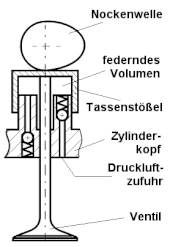Pneumatic valve spring
The pneumatic valve spring is a special form of the valve spring which, as part of the valve control of internal combustion engines, is responsible for controlling the gas exchange .
description
High engine speeds are limited by resonance frequencies in the valve train and thus also by the mass of the valve springs. For this reason, motors designed for extremely high speeds - e.g. B. almost 20,000 min −1 in racing engines - pneumatic valve springs are increasingly used. Either the valve itself or (if present) a bucket tappet is designed as part of the piston of a pneumatic cylinder . Pressure-regulated air is introduced into the cylinder via a supply line, a check valve prevents the air, which is strongly compressed during the working stroke of the valve, from escaping into the supply line. A pressure relief valve limits the internal pressure in the cylinder.
Other possibilities for valve control for very high engine speeds are electromagnetic and electrohydraulic controls. Other solutions have been tried in the past without being able to gain any significant acceptance. For reasons of space, hairpin valve springs are less suitable for multi-cylinder engines and presumably do not allow the very high speed level of pneumatic springs. Springless desmodromic valve controls have a very high mechanical effort because they require their own cams to open and close the valves; Desmodromic valve controls with a control cam used jointly for opening and closing are already historic.
literature
- Wolfgang Semet: Development of a pneumatic valve spring for high-speed series engines. Dissertation University of Stuttgart, 2007. [1]
